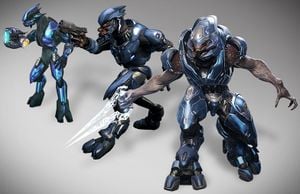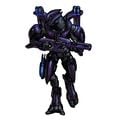Sangheili harness: Difference between revisions
From Halopedia, the Halo wiki
Sith Venator (talk | contribs) No edit summary |
Sith Venator (talk | contribs) |
||
| Line 154: | Line 154: | ||
*''[[Halo: The Television Series]]'' | *''[[Halo: The Television Series]]'' | ||
**''[[Contact]]'' | **''[[Contact]]'' | ||
**''[[Unbound]]'' | |||
**''[[Emergence]]'' | |||
{{col-end}} | {{col-end}} | ||
Revision as of 15:34, April 1, 2022

This article is part of a series on
Sangheili
- Technology
- History
- Culture, Politics & Economy
To check out information for other sapient species, see here!
Sangheili harness refers to a wide variety of armor systems used by the Sangheili soldiers of the Covenant during its time and its splinter groups. The differences between harnesses depend on rank, function, or style. Some harnesses are used by Sangheili of many ranks, while others are more restricted.[1]
Though the combat harness is only one variant among many other Sangheili harnesses, the term "combat" is sometimes used off-handedly in a synecdochical manner when referring to other Sangheili harnesses, as the combat harness is the most basic, well-known, and widespread armor variant.[2][3]
Specifications
High-ranking Sangheili may choose between a standard or ornamental design.[4][5] Gold coloration is universally associated with field command authority.[6][7][8] The Sangheili harness is almost always equipped with energy shielding, with some variants featuring enhanced shields.[9] It also boosts the speed and strength of its user, though it remains less effective than the human-made MJOLNIR Powered Assault Armor.[10]
History
The Covenant Empire originally applied a fairly structured coding for both combat and ceremonial roles—with Sangheili-derived livery choices subsisting on the margin.[1] After the empire's collapse, the armor color coding loosened significantly.[8] In 2525, science lances were dispatched to the Chi Ceti system by the Prophet of Regret to study captured technology and equipment from the Damascus Testing Facility.[11] Their efforts were presumably unsuccessful, as the facility was held and continued to develop new MJOLNIR armor variants throughout the Human-Covenant War[12] and in the years that followed.[13]
Human design attempts
After the Human-Covenant War, the UNSC, ONI and various private corporations started developing a number of armor permutations based on Sangheili armor technology for the MJOLNIR (GEN2) platform. This was done either by cooperating with human-allied Sangheili—like those from the Swords of Sanghelios—, or by independent research, testing, and reverse-engineering, sometimes bordering on disrespect for safety protocols.
The ANUBIS-class helmet's enhanced sensor suite was developed in collaboration with Sangheili, though ONI security paranoia has slowed technology integration.[14] The COPPERHEAD's external appearance and heads-up display bear Sangheili features, though it was not built from Sangheili technology properly. This Mjolnir variant is for militarized anthropology, including xenoanthropology.[14] The FREEBOOTER's seamless nanofabricated armor panels hint at a Sangheili trade link. It is produced by Beweglichkeitsrüstungsysteme.[14] The VALKYRIE-class Mjolnir is fully compatible with all known human and Covenant flight systems alike.[14]
Sangheili-sourced high-tier nanolaminates and scanning elements make the Dauntless sensor grid and faceplate outrageously expensive even by Watershed Division standards.[14] The Saturnine VISR hardware is fully compatible with Sangheili combat harness power and data feeds, leading some to believe it is intended for export.[14]
The HELIOSKRILL was developed by a Sangheili artisan-armorer prodigy who managed to crack through the MJOLNIR platform thanks to her skill. This Mjolnir variant is produced by Kolaar Manufactorum. The name comes from a predatory creature from Sanghelios.[14]
Types
- Assault harness - The Assault harness is an ancient type of armor that is fully sealed. Formerly restricted by the Covenant, dissident Sangheili decided to reuse it during the Covenant civil war.[15]
- Combat harness - The combat harness is the ubiquitous armor system available to Sangheili of all ranks. The armor exists in a wide range of colors, and there are slight functional and aesthetic variations.[16][4]
- Commando harness - The Commando harness is a lighter and sturdier variant. It is equipped with hardened communications gear and uplink capabilities, for use by Commando Units.[15]
- Flight harness - The Flight harness is a sealed armor destined for pilots of space fighters, such as the Tarasque heavy fighter and the Gigas fighter-bomber.[15]
- Infiltration harness - The Infiltration harness is an armor equipped with active camouflage technology.[17] As such, it is commonly used by Special Operations and Stealth Sangheili.[5][18]
- Outrider harness - The Outrider harness is an upgraded armor destined to improve survivability and effectiveness for its user, especially during risky missions on frontier worlds.[19]
- Ranger harness - The Ranger harness is a sealed armor used for extra-vehicular activity. There are many variations, including some derived from the Assault or Storm platforms.[20][21][22]
- Storm harness - The Storm harness is a variant produced by Lodam Armory originally for specialized shock troopers who operated on frontier worlds. The Storm variant gained prominence during the Sangheili civil war.[16][22]
- Ultra-class armor - The armor is mostly worn by Sangheili Ultras, though it is not restricted to them. It is typically of a glistening white.[23] Some feature secondary red markings and a crested helmet.[5]
- Seneschal harness
- Warrior-class harness - This type of harness is reinforced with a shield-bolstering pauldron system. It also has an accentuated helmet design.[24] The armor is typically golden, signifying a command position.
- Commander-class harness - The Commander-class harness is fielded by Sangheili who were experienced officers of the Covenant.[16][25] It has an ornate helmet very similar to that of the Officer variant.[26]
- General harness - The harness used by Generals is golden, signifying their role as field masters. It features a command helmet.[27]
- Officer harness - Contrary to standard Majors who use the combat harness, the Officer subclass is equipped with a more ornate harness and helmet.[28] It exists in dark golden red and matte burgundy.[5][18]
- Invader harness - The Invader harness was a ceremonial armor used by Sangheili hunting lodges. Since the dissolution of the Covenant, it has been modernized for combat against the Jiralhanae.[19]
Political harnesses
- Kaidon harness - The noble Kaidons have donned a variety of ceremonial battledresses with different styles and colors throughout Sangheili history.[16][29][30]
- High Councilor harness - The High Councilors were equipped with a large, ornamental helmet.[4] A similar but highly stylized version of this armor was also in use for Imperial Admirals.[31]
Specialty harnesses
- Arbiter body armor - The Arbiter armors were an extremely rare type of harness only donned by ancient Sangheili judge-kings, and by specific Sangheili appointed by the Hierarchs during the Covenant era.[32][16]
- Executioner's harness - Worn by an executioner, this harness appears to have an ornate helmet.[33]
- Imperial Admiral harness
- Artifact retrieval harness - This harness was used to recover Forerunner artifacts. It has a breathing apparatus that enables breathing in hazardous environments. Sesa 'Refumee's detachment used this set.
- Honor Guard harness - The harness was a highly ornamented, ceremonial equipment issued to Sangheili Honor Guardsmen.[4][34] The elite Lights of Sanghelios wore a bright-white base armor variant, instead of crimson red.[35]
- Artisan harness
- Keepward harness
- Scion harness
- Ossoona harness
Religious order harnesses
- Hesduros-styled Zealot-class harness - The harness's design is used by Zealots and Kaidons who originate from Hesduros. This traditional armor has a very organic, irregular surface.[36]
- Ceremonial battle harness - The ceremonial battle harness refers to an ornamental armor used by some chapters of Sangheili Zealots.[16][5][18] A variation is also used by the Field Marshal subclass.
- Ascetic harness - The Ascetic harness is an ancient design utilized by a religious order that was reactivated during the Great Schism. It features a traditional bladed mandible guard.[37]
Human designed harnesses
Gallery
Concept art of a Sangheili Minor's combat harness.
- HR EliteCommando Concept.jpg
Concept art of a cut Sangheili armor permutation bearing resemblance to the Commando harness.
Atriox holding a spiked Sangheili helmet in Halo Wars 2.
A Sangheili wearing a silver harness in Halo: The Television Series.
List of appearances
Sources
- ^ a b Halo Waypoint: Canon Fodder - Clarity & Grace
- ^ Halo: The Essential Visual Guide, pages 56, 60
- ^ Halo 4: The Essential Visual Guide, pages 28, 48
- ^ a b c d Halo 2: Anniversary
- ^ a b c d e Halo: Reach
- ^ Halo 2: The Official Strategy Guide, page 141
- ^ Halo: The Great Journey: The Art of Building Worlds, page 52
- ^ a b Halo Archive: Canon Fodder Thread GrimBrother One's comment
- ^ Halo: The Essential Visual Guide, pages 57, 60
- ^ Halo Encyclopedia (2011 edition), page 131: "The Elite Combat Harness is the standard armor used by the Sangheili in all Covenant conflicts. Similar to the Spartans' mark VI in that it boosts speed and strength while adding a personal energy shield, the armor is actually less advanced and can withstand less damage than a Spartan's armor."
- ^ Halo Wars, Timeline
- ^ Halo: The Essential Visual Guide, page 85
- ^ Halo 4 Infinity multiplayer trailer
- ^ a b c d e f g Halo 5: Guardians
- ^ a b c Halo 3
- ^ a b c d e f Halo Waypoint: Canon Fodder - Fighting Words
- ^ Halo: The Essential Visual Guide, page 59
- ^ a b c Halo: Combat Evolved Anniversary
- ^ a b Halo Waypoint: Canon Fodder - Marching On
- ^ Halo: The Essential Visual Guide, page 58
- ^ Halo Waypoint: Canon Fodder - Brute Force
- ^ a b Halo Waypoint: Canon Fodder - Fury's Road
- ^ Halo Waypoint: Hints and Heroes
- ^ Halo 4: The Essential Visual Guide, p. 29, 48
- ^ Halo 4: The Essential Visual Guide, page 47
- ^ Halo 4
- ^ Halo: The Essential Visual Guide, page 57
- ^ Halo Encyclopedia: The Definitive Guide to the Halo Universe, page 135 (2011 edition)
- ^ Halo Waypoint: Arbiter Thel Vadam
- ^ Ultra-Combo.com: Arbiter’s Colors & Accessories
- ^ Halo: Fleet Battles
- ^ Halo 2: Anniversary: Terminals
- ^ Halo Wars 2, campaign level, A New Enemy
- ^ Halo: The Essential Visual Guide, page 95
- ^ Halo Waypoint: Covenant Honor Guard
- ^ Halo 4: The Essential Visual Guide, pages 27, 49
- ^ Halo: The Essential Visual Guide, page 56











